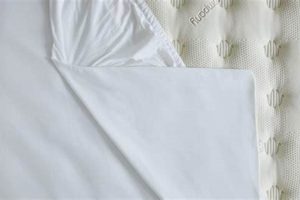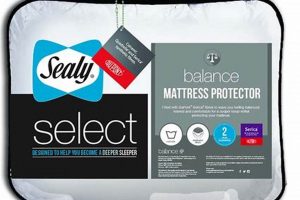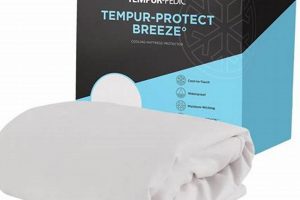The process of cleaning a cover designed to shield a bed from spills, stains, and allergens is essential for maintaining hygiene and extending the lifespan of both the mattress and the protector itself. This cleaning procedure typically involves removing the cover from the bed, pretreating any visible stains, laundering it in a washing machine with appropriate detergent, and thoroughly drying it before replacing it on the mattress.
Regular cleaning offers several benefits. It prevents the buildup of dust mites, dead skin cells, and other allergens that can trigger allergic reactions and respiratory problems. Furthermore, it helps to eliminate odors and keep the sleeping surface fresh. Historically, protecting mattresses involved less sophisticated methods, such as using thick cotton sheets. Modern mattress protectors offer superior protection and are designed for easy care, making regular cleaning a straightforward and valuable hygiene practice.
The following sections will outline specific steps for washing a mattress cover effectively, including pretreating stains, selecting the correct wash cycle and detergent, and ensuring proper drying to prevent damage. Different types of protectors may require specific care, which will also be addressed.
Washing Mattress Covers
The subsequent advice aims to provide individuals with effective methods for laundering mattress covers, ensuring both cleanliness and preservation of the material.
Tip 1: Check the Care Label. Always consult the manufacturer’s care label before washing. This label provides crucial information regarding recommended water temperature, drying methods, and permissible cleaning agents. Ignoring these instructions could result in damage to the protector.
Tip 2: Pretreat Stains Promptly. Address stains as soon as they are noticed. Use a mild stain remover or a solution of diluted detergent to gently blot the affected area. Avoid harsh chemicals like bleach, which can degrade the fabric.
Tip 3: Select a Gentle Wash Cycle. Opt for a gentle or delicate cycle when machine washing. This reduces the mechanical stress on the cover, minimizing the risk of tearing or deformation. A lower spin speed is also preferable.
Tip 4: Use a Mild Detergent. Choose a mild, hypoallergenic detergent. Harsh detergents can leave residue on the fabric, potentially causing skin irritation or degrading the waterproof lining of some protectors.
Tip 5: Avoid Fabric Softeners. Refrain from using fabric softeners, as they can diminish the waterproof or water-resistant properties of the cover. These products may also leave a coating that traps moisture and promotes the growth of mold or mildew.
Tip 6: Dry on Low Heat or Air Dry. Tumble dry the cover on a low heat setting or, ideally, air dry it. High heat can damage the waterproof membrane or cause shrinkage. Ensure the protector is completely dry before replacing it on the mattress to prevent moisture buildup.
Tip 7: Wash Regularly. Establish a regular washing schedule. Typically, washing the mattress cover every one to two months is sufficient for maintaining cleanliness. However, more frequent washing may be necessary if spills or accidents occur.
By adhering to these guidelines, individuals can effectively maintain the cleanliness and integrity of their mattress covers, thereby prolonging the life of both the cover and the underlying mattress.
These tips provide the groundwork for properly maintaining your mattress cover, leading into a final summary.
1. Read care label
The directive to “Read care label” constitutes a fundamental step in determining the appropriate method for laundering a mattress cover. It provides specific manufacturer instructions that, when followed, minimize the risk of damage and maximize the effectiveness of the cleaning process. The information contained on the care label is critical for ensuring the protector is cleaned in a manner that preserves its protective properties and extends its usable life.
- Material Composition and Temperature Sensitivity
The care label typically specifies the material composition of the protector, which is essential for selecting the correct washing temperature. For instance, protectors with a waterproof membrane may be sensitive to high heat, requiring a cold or warm water wash to prevent delamination. Ignoring these temperature recommendations can lead to irreversible damage to the protective barrier, rendering the cover ineffective.
- Detergent Compatibility
Certain materials may react negatively to specific detergents. The care label often provides guidance on the types of detergents that are safe to use. For example, some labels may advise against using bleach or harsh chemicals, as these can degrade the fabric fibers or compromise the integrity of the waterproof layer. Using a recommended mild detergent is crucial for maintaining the cover’s performance.
- Drying Instructions and Heat Resistance
The drying instructions are particularly important for preventing shrinkage or damage to the protector’s shape. The label may indicate whether the protector can be tumble dried and, if so, the appropriate heat setting. Some protectors may require air drying to prevent deformation or melting of the waterproof lining. Adhering to the recommended drying method is vital for preserving the fit and function of the cover.
- Specific Washing Instructions
Beyond temperature and detergent recommendations, the care label might outline unique washing instructions. These could include specific cycle settings (e.g., delicate, gentle), instructions to wash separately, or pre-treatment advice. These nuanced instructions cater to the specific construction and materials of the protector, ensuring a thorough yet gentle cleaning process.
By diligently examining and adhering to the care label, individuals can ensure they are using the correct methods to clean their mattress protectors. This practice not only extends the life of the protector but also maintains its ability to effectively shield the mattress from spills, allergens, and other contaminants, thereby contributing to a cleaner and healthier sleep environment.
2. Pretreat stains
The action of pretreating stains forms an integral, causative element in the comprehensive process of cleaning a mattress cover. The efficacy of the washing process hinges, to a significant degree, on addressing stains prior to the main wash cycle. Untreated stains, especially those resulting from organic matter or spills, tend to set into the fabric fibers during the washing process, becoming more difficult, if not impossible, to remove completely. This is because the heat and agitation of the washing machine can bind the staining agents more tightly to the material.
The application of a stain remover, whether a commercially available product or a homemade solution (e.g., a mixture of water and mild detergent), loosens the bonds between the stain and the fabric. This pre-treatment allows the detergent in the washing machine to work more effectively at lifting and removing the stain particles. For example, a blood stain left untreated on a mattress cover prior to washing is likely to remain visible, even after a thorough cleaning. Conversely, pretreating the same stain with a cold water and hydrogen peroxide solution can significantly improve the outcome. Similarly, pretreating greasy stains with a powdered substance like baking soda to absorb the oil before washing increases the chance of complete removal. This step is particularly critical for mattress covers, as their often bulky nature makes them less amenable to repeated washings, and certain materials may be more sensitive to harsh cleaning methods.
In summary, stain pre-treatment is not merely an optional addendum to the washing procedure; it is a critical step that directly impacts the overall cleanliness and longevity of the mattress protector. Ignoring this step can lead to permanent staining and necessitate premature replacement of the cover, thereby diminishing its cost-effectiveness and negating the hygienic benefits it is intended to provide. Therefore, understanding the necessity and correct application of stain pre-treatment is essential for effectively maintaining a clean and protected sleep environment.
3. Gentle cycle
The selection of a gentle wash cycle represents a crucial component in the appropriate methodology for laundering a mattress protector. This cycle, characterized by reduced agitation and a slower spin speed, directly impacts the integrity and longevity of the protector’s materials. The alternative, a more aggressive wash cycle, poses a significant risk of damage. Stronger agitation can lead to tearing of the fabric, particularly in areas of pre-existing wear or stress. The higher spin speeds associated with standard cycles subject the material to increased centrifugal force, potentially compromising waterproof membranes or causing delamination of multiple layers. The selection of an adequate wash cycle is a critical decision when it comes to “how to wash a mattress protector”.
Consider a scenario involving a mattress protector with a polyurethane waterproof backing. Exposing this type of protector to a high-speed spin cycle might cause the backing to separate from the fabric layer, rendering it ineffective as a barrier against liquids. Similarly, a protector constructed from quilted cotton could experience significant distortion and shrinkage if subjected to a hot water wash and vigorous agitation. Conversely, a gentle cycle minimizes these risks, allowing the protector to be cleaned effectively while preserving its structural integrity. Moreover, utilizing a gentle cycle helps to prevent excessive wear and tear on seams and closures, such as zippers, further extending the useful life of the protector.
In summary, the application of a gentle wash cycle in the context of “how to wash a mattress protector” transcends mere preference; it is a practical necessity. By mitigating the physical stresses imposed during the washing process, a gentle cycle ensures the protector remains functional and continues to provide adequate protection to the underlying mattress. Proper execution of this component of mattress protector maintenance contributes directly to both hygiene and cost-effectiveness, and has to be included in the instructions about “how to wash a mattress protector”.
4. Mild detergent
The selection of a “mild detergent” is a pivotal consideration in the process of “how to wash a mattress protector.” This choice directly influences the longevity and protective qualities of the item. Unlike harsh chemical formulations, a mild detergent offers a balanced approach to cleaning, effectively removing soils without compromising the integrity of the protector’s materials.
- Preservation of Fabric Integrity
Harsh detergents often contain bleaching agents and strong enzymes that can degrade the fabric fibers of a mattress protector over time. Mild detergents, conversely, are formulated to gently lift away dirt and allergens without causing excessive wear and tear. For instance, continuous washing with a harsh detergent could weaken the waterproof lining of a protector, reducing its ability to prevent liquid penetration. The use of a mild detergent prolongs the fabric’s life, thus maintaining its protective function.
- Maintaining Waterproof Properties
Many mattress protectors feature a waterproof or water-resistant membrane, often made of polyurethane or a similar material. These membranes are susceptible to damage from harsh chemicals. A mild detergent is less likely to dissolve or compromise this layer, ensuring that the protector continues to effectively block liquids. An example of this would be a protector that, after multiple washes with a strong detergent, loses its ability to repel spills, thereby failing to protect the mattress from staining.
- Minimizing Allergenic Residue
Residue from harsh detergents can remain embedded in the fabric of a mattress protector even after rinsing. These residues can act as irritants, triggering allergic reactions or skin sensitivities, particularly in individuals with eczema or other dermatological conditions. Mild detergents, designed with hypoallergenic properties, reduce the likelihood of such reactions, promoting a healthier sleep environment. Using a product specifically formulated for sensitive skin can further minimize this risk.
- Preventing Color Fading
Mattress protectors, particularly those with colored fabrics or patterns, are vulnerable to fading when washed with aggressive detergents. The bleaching agents present in these detergents strip away the dye molecules, leading to a gradual loss of color intensity. Mild detergents, free from harsh bleaching agents, help to preserve the original color and appearance of the protector, maintaining its aesthetic appeal over repeated washings.
In summary, the strategic utilization of a mild detergent is integral to the proper execution of “how to wash a mattress protector.” By safeguarding fabric integrity, preserving waterproof properties, minimizing allergenic residue, and preventing color fading, this approach ensures the protector continues to perform its intended function effectively, thus extending the lifespan of both the protector and the mattress it is designed to safeguard.
5. Avoid softener
The instruction to “Avoid softener” is a critical element within the broader framework of “how to wash a mattress protector.” The use of fabric softeners, while seemingly beneficial for textile care, presents several potential adverse effects when applied to mattress protectors, primarily due to the materials typically used in their construction. The exclusion of fabric softener from the laundering process is not merely a matter of preference but a preventive measure against compromising the protector’s intended functionality.
Fabric softeners function by depositing a coating of lubricating chemicals onto fabric fibers. This coating imparts a soft feel but simultaneously reduces the absorbency of the material. For mattress protectors designed to be waterproof or water-resistant, this reduction in absorbency can be particularly problematic. The softener coating can clog the pores of the fabric, hindering its ability to wick away moisture or repel liquids, thereby diminishing its primary protective function. For instance, a mattress protector treated with fabric softener may become less effective at containing spills, allowing liquids to seep through and stain the mattress beneath. Furthermore, the chemical residue left by softeners can degrade the waterproof membrane over time, leading to cracks and breaches in the protective barrier. This degradation is often accelerated by repeated washings. Another potential issue stems from the interaction of softener residue with body oils and sweat. This combination can create a buildup of hydrophobic substances within the fabric, fostering an environment conducive to bacterial growth and unpleasant odors. This is counterproductive to the goal of maintaining a clean and hygienic sleep surface.
In conclusion, adhering to the directive to “Avoid softener” is essential for preserving the functional integrity and longevity of mattress protectors. The seemingly benign addition of fabric softener can, in fact, undermine the protector’s capacity to effectively shield the mattress from spills and allergens, while also potentially promoting bacterial growth and odor retention. Therefore, a comprehensive understanding of “how to wash a mattress protector” necessitates a firm recognition of the detrimental effects associated with the use of fabric softeners in this context.
6. Low heat dry
The instruction to use “Low heat dry” is an essential component of the established methodology for “how to wash a mattress protector.” This directive stems from the potential for high heat to inflict irreversible damage on the materials commonly used in protector construction. The application of high heat during the drying process can lead to shrinkage, warping, and degradation of waterproof or water-resistant membranes, thus compromising the protector’s primary function. This instruction ensures mattress protectors are clean with no heat damage.
For instance, many protectors feature a polyurethane layer designed to prevent liquids from penetrating. Exposing this layer to high temperatures can cause it to melt, crack, or delaminate from the fabric backing, rendering the protector ineffective. Similarly, protectors made from quilted cotton or synthetic blends are susceptible to shrinkage at high temperatures, leading to a distorted shape and an ill-fitting cover. A protector that no longer fits snugly onto the mattress loses its ability to provide adequate protection against spills and allergens. Furthermore, prolonged exposure to high heat can weaken the fabric fibers, reducing the protector’s overall durability and lifespan. A real-world example is a situation where a protector dried on high heat shrinks, making it difficult to put back on the mattress and leaving portions of the mattress exposed, making it very vulnerable.
In summary, the recommendation to use “Low heat dry” is not merely a suggestion but a critical step in the process of “how to wash a mattress protector.” It serves to safeguard the structural integrity and functional properties of the protector, ensuring that it continues to provide reliable protection to the mattress. Adherence to this guideline is essential for maximizing the lifespan and effectiveness of the mattress protector, making it an important issue about “how to wash a mattress protector.”
7. Wash Regularly
The practice of “Wash Regularly” is an indispensable element within the comprehensive guide on “how to wash a mattress protector.” Its adherence directly influences the cleanliness, hygiene, and longevity of both the protector and the underlying mattress. A systematic washing schedule mitigates the accumulation of allergens, body oils, and other contaminants, fostering a healthier sleep environment.
- Allergen Mitigation
Dust mites, pet dander, and pollen accumulate within mattress protectors over time. Regular washing removes these allergens, reducing the risk of allergic reactions and respiratory problems. For example, an individual with asthma may experience fewer nighttime symptoms if the mattress protector is washed on a consistent basis. Conversely, infrequent washing allows allergens to proliferate, potentially exacerbating allergic conditions.
- Hygiene Maintenance
Body oils, sweat, and dead skin cells are inevitably transferred to the mattress protector during sleep. These substances can create an environment conducive to bacterial growth and unpleasant odors. Regular washing removes these contaminants, maintaining a clean and hygienic sleep surface. Failure to wash the protector regularly can result in a buildup of these substances, leading to stains and a less sanitary sleeping environment.
- Stain Prevention and Removal
Accidental spills and stains are common occurrences. Prompt and regular washing of the mattress protector can prevent stains from setting into the fabric and becoming permanent. Early intervention significantly increases the likelihood of successful stain removal, preserving the protector’s appearance and functionality. Allowing stains to remain untreated for extended periods makes them more difficult to remove and can ultimately compromise the protector’s protective capabilities.
- Longevity of the Protector
Regular washing, when performed correctly, can extend the lifespan of the mattress protector. Removing accumulated dirt and debris prevents the breakdown of fabric fibers and waterproof membranes. A well-maintained protector will provide effective protection for a longer period, delaying the need for replacement. Neglecting regular washing can lead to premature wear and tear, necessitating more frequent replacements and increasing overall costs.
In conclusion, the directive to “Wash Regularly” is not merely a supplementary recommendation but an integral component of “how to wash a mattress protector.” By mitigating allergens, maintaining hygiene, preventing stains, and prolonging the protector’s lifespan, this practice ensures a cleaner, healthier, and more cost-effective sleep environment. The frequency of washing should be adjusted based on individual needs and circumstances, but a consistent schedule is crucial for optimal results.
Frequently Asked Questions
The following section addresses common inquiries regarding the proper care and cleaning of mattress protectors, providing factual and objective information to ensure optimal maintenance.
Question 1: How frequently should a mattress protector be washed?
A mattress protector should be washed every one to two months under normal conditions. More frequent washing may be necessary if spills, stains, or allergen concerns are present.
Question 2: Can all mattress protectors be machine washed?
The majority of mattress protectors are machine washable. However, it is imperative to consult the manufacturer’s care label for specific instructions. Certain materials or construction methods may necessitate alternative cleaning approaches.
Question 3: What water temperature is recommended for washing a mattress protector?
A cold or warm water setting is generally recommended to prevent shrinkage and damage to waterproof membranes. The care label should be consulted for definitive guidance.
Question 4: Is it permissible to use bleach when washing a mattress protector?
The use of bleach is generally discouraged, as it can degrade the fabric and compromise the integrity of waterproof layers. Alternative stain removal methods are preferable.
Question 5: How should a mattress protector be dried after washing?
Tumble drying on a low heat setting or air drying are the recommended methods. High heat can cause shrinkage and damage to waterproof components. Ensure the protector is completely dry before replacing it on the mattress to prevent mold or mildew growth.
Question 6: What type of detergent is best suited for washing a mattress protector?
A mild, hypoallergenic detergent is recommended to minimize the risk of skin irritation and preserve the integrity of the fabric. Harsh detergents should be avoided.
Proper adherence to the outlined guidelines ensures the longevity and effectiveness of the mattress protector.
The subsequent sections will detail specific considerations for different types of mattress protectors and cleaning scenarios.
Concluding Remarks
This exploration of how to wash a mattress protector has emphasized critical elements for maintaining cleanliness and preserving the protective qualities of the item. Adherence to manufacturer instructions, judicious stain pre-treatment, the selection of gentle wash cycles and appropriate detergents, and careful drying methods are paramount. Regular washing, as delineated, ensures the removal of allergens, body oils, and other contaminants that compromise hygiene and contribute to material degradation.
The sustained effectiveness of a mattress protector depends on consistent and informed care. Neglecting proper cleaning protocols will inevitably lead to diminished performance and premature replacement. Prioritizing these guidelines is a responsible measure, ensuring a healthier sleep environment and maximizing the investment in mattress protection.






![Best Malouf Mattress Protector [Guide & Review] Organic & Natural Mattress Buyer’s Guide: Non-Toxic Sleep Solutions Best Malouf Mattress Protector [Guide & Review] | Organic & Natural Mattress Buyer’s Guide: Non-Toxic Sleep Solutions](https://mattressworldpa.com/wp-content/uploads/2025/07/th-2531-300x200.jpg)
![Best Purple Protector Mattress: [Benefit] & Protection! Organic & Natural Mattress Buyer’s Guide: Non-Toxic Sleep Solutions Best Purple Protector Mattress: [Benefit] & Protection! | Organic & Natural Mattress Buyer’s Guide: Non-Toxic Sleep Solutions](https://mattressworldpa.com/wp-content/uploads/2025/07/th-2530-300x200.jpg)